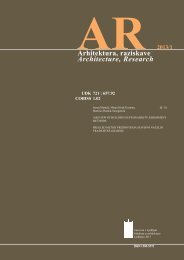Revija 2005/1 v PDF - Fakulteta za arhitekturo - Univerza v Ljubljani
Revija 2005/1 v PDF - Fakulteta za arhitekturo - Univerza v Ljubljani
Revija 2005/1 v PDF - Fakulteta za arhitekturo - Univerza v Ljubljani
You also want an ePaper? Increase the reach of your titles
YUMPU automatically turns print PDFs into web optimized ePapers that Google loves.
AR 2oo5 / 1Dejan Jakhel, Maj Juvanec, Domen ZupanèièBorut JuvanecMEDIJSKA PREDSTAVITEV RAZISKAVE" KAMEN NA KAMEN"MEDIA REPRESENTATION OF THE RESEARCH" STONE UPON STONE"raziskava, researchpovzetekMedijska predstavitev raziskave je postavitev znanstvenihrezultatov na internet.Raziskava Kamen na kamen / Stone upon Stone je raziskovalnanaloga, ki je tekla v letu 2oo3, oddana pa je bila na Univerzi v<strong>Ljubljani</strong>, <strong>Fakulteta</strong> <strong>za</strong> <strong>arhitekturo</strong> 2oo4. Vsebina <strong>za</strong>okrouje <strong>za</strong>èetkein izvore arhitekture v kamnu, konstrukcijo, tipiko in teorijo terokolje, konèuje s problematiko. Posebna poglavja so indeks, viri inliteratura ter povzetki v slovenšèini, anglešèini, nemšèini, hrvašèiniin v kastilšèini. Raziskava je postavljena v formatu 2o x 28 cm inobsega 141 strani teksta s slikami. Slikovno gradivo so fotografije,skice, risbe, sheme, raèunalniške sheme na fotografijah,fotografirani leseni modeli in raèunalniške simulacije. Vse gradivoje v barvah. Tu so tudi podatki o avtorju ter tri recenzije. Recenzentiso bili prof Christian Lassure, CERAV, Pariz; prof dr Paul Oliver,Oxford Brookes University; dr Berislav Horvatiè, Institut <strong>za</strong> fizikuRH, Zagreb.Vsebinsko je medijska predstavitev z naslovom The Stonerazdeljena na elemente (<strong>za</strong>radi Neta je vse tekstualno gradivo vanglešèini):teoretièni del, ki vsebuje 10 poglavijabstract, history, construction, typics, theory, objects, environment,problematics, links, bibliography,dokumentacija, v kateri je trenutno predstavljeno 18 tipovkamnitih <strong>za</strong>toèišè Mediterana, po Evropi, pa tudi v Palestini, naSinaju in v Jemnu. Vsak tip <strong>za</strong>toèišèa je predstavljen s krajšimtekstom, makro in mikro zemljevidom lokacije in nekajfotografijami. Zaradi relativno visokega odstotka uporabnikovinterneta (do 30% - odvisno od ciljne publike), ki še vedno uporablja15 palène monitorje z loèljivostjo 800 x 600 pikslov, je izbranaefektivna širina strani 760 px. Vsa navigacija in bistveni podatki soznotraj te meje, tako da lahko tudi obiskovalci z najmanjšimi ekraninemoteno brskajo po strani. Strani so centrirane na levi rob ekrana,na desni pa se pri veèjih ekranih po širini nekaj grafiènih elementovrazširi po vsem ekranu tudi pri veèjih loèljivostih (širina 100%).Gradivo je izrazito interaktivno: vsebini lahko sledimo po vrstnemredu od <strong>za</strong>èetka do konca (v celoti ali le s povzetki), dosegljiva soposamièna poglavja, objekte pa lahko izbiramo po abecedi (lokalnihizrazov), po deelah ali po karti Evrope (s severnim delomAfrike).doseeni cilji, namen in rezultatiCilj je bil podati celovito informacijo o objektih korbelinga, odteorije do prakse in do stanja objektov v prostoru. Rezultat jedigitalna informacija o predstavitvi v vseh kljuènih brskalnikih.problematika v arhitekturi, umestitevobravnavane teme v te tokove in njen pomenArhitektura kamna je najstarejša arhitektura, kar jih poznamo.Vernakularna arhitektura postaja v svetovnem okviru vse boljpomembna in je umešèena v pedagoške procese vseh pomembnejšihšol <strong>za</strong> <strong>arhitekturo</strong> (Oxford, Rim, Valencia, Paris, Lausanne,Grenoble, Trento, Milano).Raziskava je dosegljiva v Knjinici FA.Naslov: www.stoneshelter.orgkljuène besedekamen, vernakularna arhitektura, <strong>za</strong>toèišèe, korbelingsummaryThe media presentation of the research is placement of scientificresults on the Internet.The research Stone upon Stone was carried out during 2003 andpublished by the University of Ljubljana, Faculty of Architecture, in2004. The content encompasses the beginnings and sources ofarchitecture in stone, structure, typology, theory and environmentand concludes with the issues. Separate chapters are: index, sourcesand literature and abstracts in Slovene, English, German, Croat andSpanish. The layout was done in a 20x28 cm format and contains 141pages of text with figures. The graphic material containsphotographs, sketches, drawings, computer schemes onphotographs, photographed wooden models and computersimulations. All is in full colour. Data about the reviewers is added.They were: Prof. Christian Lassure, CERAV, Paris; Prof. dr. PaulOliver, Oxford Brookes University, Oxford; Dr. Berislav Horvatiè,Institute for physics, Zagreb.The content of the media presentation, titled The Stone, is dividedinto elements (because of the web, all textual material is in English):The theoretical part contains 10 chapters: abstract, history,construction, typology, theory, objects, environment, issues, links,bibliography, documentation, which presently contains 18 types ofstone shelters from the Mediterranean basin, Europe, as well asPalestine, Sinai and Yemen. All types of shelters are presented byshort texts, macro- and micro-maps of the site and severalphotographs.Because of the relatively high share of internet users(up to 30 % - depending on the goal public) who still use 15 inchmonitors and resolution 800 x 600 pixels, the selected effective pagewidth is 760 px. All navigation and essential data is within this range,thus visitors with smaller monitors can also surf the pages easily. Thepages are justified to the left side of the monitor, with wider monitorscertain graphical elements expand across the whole screen (width100 %).The material is exceptionally interactive: the content can befollowed in order, from beginning to end (comprehensively or only byabstracts), separate chapters are easily reached; buildings can beselected by alphabetical order (local names), country or a map ofEurope (with Northern Africa).intentions, goals and resultsThe goal was to present comprehensive information aboutcorbelled objects, from theory to practise and the condition ofbuildings in space. The result is digital information aboutpresentation in all key browsers.architectural issues, positioning the topicin ongoing debate and its’ significanceArchitecture in stone is the oldest known architecture.Vernacular architecture is even in the global framework becomingincreasingly important and is positioned in all pedagogic processesof all important schools of architecture (Oxford, Rome, Valencia,Paris, Lausanne, Grenoble, Trento and Milano).The research is available in the library of the Faculty of architecture.Address: www.stoneshelter.orgkey wordsstone, vernacular architecture, shelter, corbelling67
















